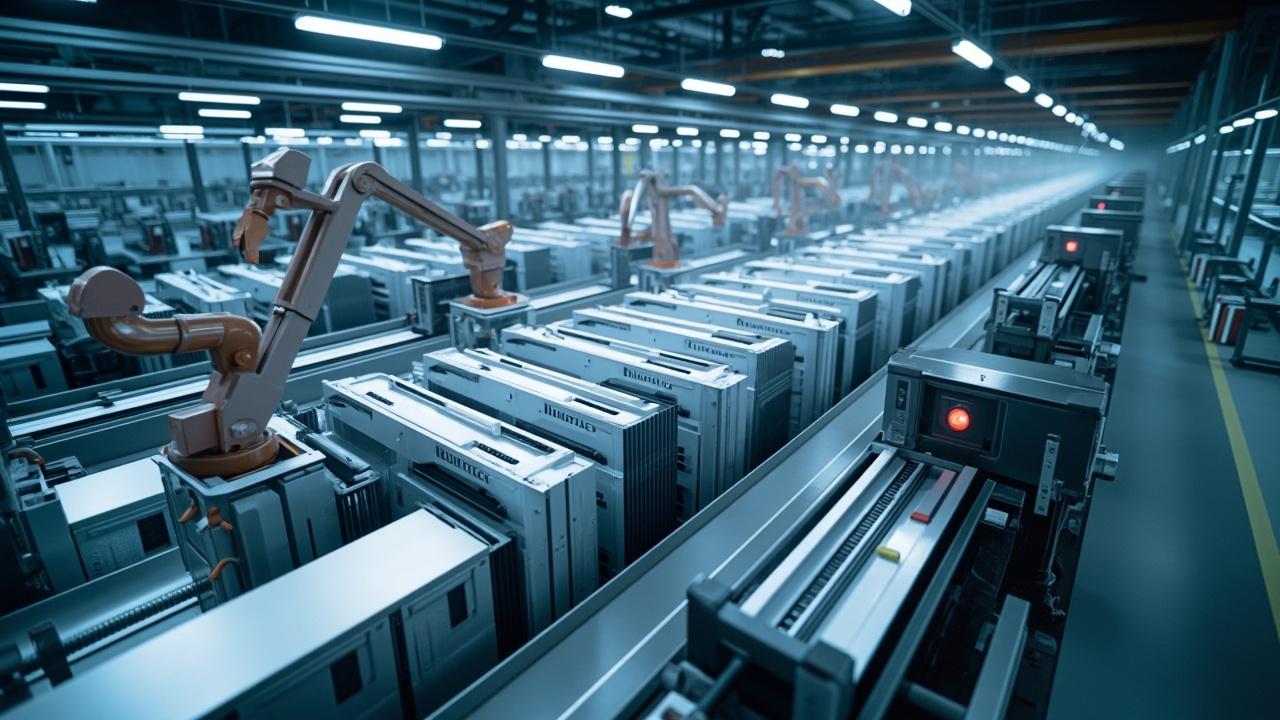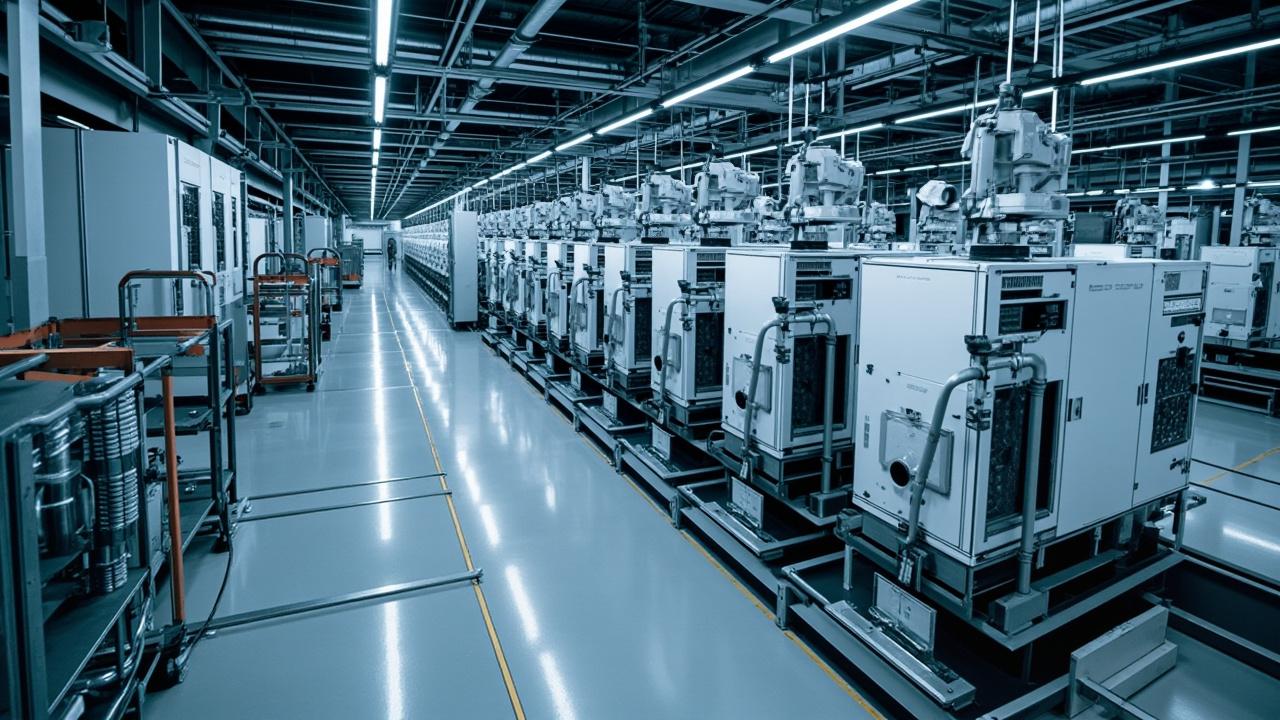Understanding the Gigafactory Mindset
Data demands are skyrocketing. The gigafactory approach, inspired by Tesla, offers a solution to construction woes. Traditional data center builds can’t keep pace with the exponential growth of data. Inefficiencies plague the sector, leading to delays, budget overruns, and significant environmental impact. But what if data center construction could be revolutionized?
Imagine a world where data centers are built faster, more efficiently, and with greater sustainability. This vision is achievable by applying the principles of the “gigafactory” – a concept popularized by Tesla’s massive battery production facilities. The gigafactory approach isn’t just about size; it’s about a fundamental shift in mindset, embracing innovation and optimization at every stage of the process.
By adopting a gigafactory methodology, the data center industry can potentially unlock unprecedented levels of speed, efficiency, cost savings, and sustainability in its construction processes. This involves a radical rethinking of how data centers are designed, built, and managed, drawing inspiration from manufacturing techniques that have transformed other industries. Let’s delve into what a gigafactory is and how its core tenets can be applied to this sector.
The Current State of Data Center Construction
Traditional data center construction is a complex undertaking, often plagued by inefficiencies that hinder progress and inflate costs. The processes involved are intricate, demanding seamless coordination between numerous contractors, specialized tradespeople, and a web of suppliers. This complexity inevitably leads to challenges in maintaining project timelines and budgets.
Here are some of the common pain points in data center construction:
- Delays and Cost Overruns: These are frequent occurrences, stemming from various factors. Permitting delays due to regulatory complexities can stall projects for extended periods. Material shortages, exacerbated by global events or supply chain disruptions, can halt construction altogether. Unpredictable weather conditions can also significantly impact outdoor construction activities, leading to further delays and increased labor costs.
- Lack of Standardization: Unlike other industries that have embraced standardization for efficiency, data center construction often suffers from a lack of uniformity. Variations in design and construction practices across different projects and regions create inefficiencies and make it difficult to replicate successful models.
- Inefficient Labor Practices: Traditional construction methods rely heavily on manual labor, which is not only time-consuming but also prone to errors. Finding and retaining skilled workers is another challenge, particularly in certain geographic areas, driving up labor costs and potentially compromising quality.
- Supply Chain Vulnerabilities: The data center industry depends on a global supply chain for critical components, making it susceptible to disruptions. Geopolitical events, natural disasters, or even fluctuations in demand can impact the availability and cost of essential materials, such as semiconductors, steel, and concrete. A robust supply chain is essential for the *gigafactory approach*.
- Sustainability Issues: Traditional construction practices often have a significant environmental impact. Waste generation is a major concern, with construction debris contributing to landfill waste. The carbon emissions associated with material production, transportation, and on-site activities also contribute to the industry’s overall carbon footprint.
These challenges highlight the need for a new approach to data center construction – one that prioritizes speed, efficiency, and sustainability. The current model struggles to keep pace with the exponential growth of data and the increasing demand for computing power. Without significant improvements, the industry risks falling behind, hindering innovation and impacting economic growth.
Applying Gigafactory Principles to Data Center Design
The design phase is crucial when considering a transformative shift in data center construction. It’s here where the seeds of efficiency, standardization, and sustainability are sown, paving the way for a successful implementation of the gigafactory approach. The integration of modular design, standardization, and advanced digital technologies is paramount to achieving the goals of speed, efficiency, and cost-effectiveness.
Here are key elements when applying the principles to Data Center Design:
- Modular Design: One of the most impactful strategies is adopting a modular design approach. This involves breaking down the data center into discrete, pre-fabricated components.
- Standardization: The efficiencies gained through modular design are amplified by standardization.
- Digital Twins & BIM: Digital Twins and BIM (Building Information Modeling) play a critical role in simulating and optimizing data center performance before physical construction begins.
Modular design brings several significant advantages. Pre-fabricated power modules, cooling systems, and server racks can be manufactured off-site in controlled environments, ensuring higher quality and minimizing on-site construction time. Modularity simplifies design because, instead of creating bespoke solutions for every project, engineers can select from a catalog of pre-designed and tested modules.
This speeds up the design process, reduces the risk of errors, and allows for easier scalability in the future. Furthermore, modular components are easier to replace and upgrade, extending the lifespan of the data center and reducing downtime.
Standardization involves using common designs and components across multiple data center projects. This streamlines the design process, simplifies procurement, and reduces the need for custom engineering. Standardized components can be manufactured in larger volumes, leading to economies of scale and lower costs. Standardized designs also make it easier to train personnel, maintain the data center, and manage inventory.
This reduces operational complexity and increases overall efficiency. By leveraging digital twins, stakeholders can simulate the entire lifecycle of the data center, from design and construction to operation and decommissioning. BIM allows for a more collaborative and integrated design process, enabling architects, engineers, and contractors to work together seamlessly and identify potential issues early on.
Optimizing Data Center Construction With a Gigafactory Approach
Off-site fabrication and assembly represent a pivotal shift in how data centers can be constructed, moving away from traditional on-site builds to a more controlled and efficient factory setting. Major data center components, such as prefabricated power modules, cooling systems, and even entire server rooms, can be manufactured and assembled in these specialized facilities. This approach offers numerous advantages, most notably improved quality control.
Within a factory environment, conditions are far more predictable and manageable compared to a construction site. This allows for tighter tolerances, more rigorous testing, and a higher overall level of quality assurance.
The reduction of waste is another significant benefit of off-site fabrication. Traditional construction often results in substantial material waste due to cutting errors, weather damage, and theft. In a factory setting, materials can be used more efficiently, and waste can be minimized through careful planning and precise manufacturing processes. Furthermore, the controlled environment allows for easier recycling and repurposing of any leftover materials.
Perhaps the most compelling advantage is the accelerated construction timelines. By manufacturing components off-site in parallel with site preparation, the overall project duration can be significantly reduced. This speedier deployment is crucial in the rapidly evolving data center landscape, where time-to-market can be a critical competitive factor.
The utilization of robots and automated systems is another cornerstone of optimizing data center construction. Robots can perform tasks that are either too dangerous, too repetitive, or too precise for human workers. For example, automated welding systems can ensure consistent and high-quality welds on structural components, while robotic arms can assemble complex modules with speed and accuracy.

Autonomous material handling systems can efficiently move components around the construction site, reducing the need for manual labor and minimizing the risk of accidents. This kind of automation not only enhances efficiency but also contributes to safer working conditions and reduces labor costs. Implementing a gigafactory approach that uses a combination of advanced manufacturing techniques will lead to higher quality and a lower cost.
| Benefit | Description |
|---|---|
| Improved Quality Control | Manufacturing in a controlled factory environment allows for tighter tolerances and rigorous testing. |
| Reduced Waste | Efficient material use and recycling in factories minimize waste generation. |
| Faster Construction Times | Off-site fabrication and assembly accelerate project timelines. |
| Enhanced Safety | Automation reduces risks associated with manual labor on construction sites. |
Supply Chain Optimization and Vertical Integration
One of the key pillars of supply chain optimization within a gigafactory model is establishing direct relationships with suppliers. Traditionally, data center construction relies on a complex web of intermediaries, each adding layers of cost and potential delays. By cutting out the middleman and engaging directly with manufacturers of critical components like servers, cooling systems, and power infrastructure, data center operators can secure more competitive pricing, negotiate favorable terms, and gain greater visibility into the supply chain.
This direct engagement also fosters stronger partnerships, allowing for collaborative problem-solving and proactive management of potential disruptions. Furthermore, direct sourcing enables data center operators to exert greater influence over the quality and specifications of the materials used, ensuring that they meet the stringent performance and reliability requirements of their facilities.
Inventory Management: Minimizing Shortages and Reducing Costs
Effective inventory management is crucial for minimizing material shortages and reducing carrying costs in data center construction. Traditional construction projects often suffer from delays caused by material shortages, which can lead to costly downtime and missed deadlines. By implementing advanced inventory management techniques, such as just-in-time (JIT) delivery and predictive analytics, data center operators can optimize their inventory levels and ensure that materials are available when and where they are needed.
JIT delivery minimizes the amount of inventory that needs to be stored on-site, reducing storage costs and the risk of obsolescence. Predictive analytics can be used to forecast demand for materials based on project timelines and historical data, allowing for proactive procurement and avoiding potential shortages. The implementation of a strategic gigafactory approach here will reduce downtime, minimize financial risks, and ensure project success.
Regional Manufacturing Hubs: Decentralizing Production for Greater Resilience
The establishment of regional manufacturing hubs is another key strategy for optimizing the data center supply chain. Rather than relying on centralized production facilities located far from the point of use, data center operators can create regional hubs that produce data center components closer to their construction sites. This approach reduces transportation costs, minimizes lead times, and enhances the resilience of the supply chain by diversifying production capacity.
Regional hubs can also be tailored to meet the specific needs of local markets, allowing for greater flexibility and customization. Furthermore, the creation of regional manufacturing hubs can stimulate local economies by creating jobs and fostering innovation.
Cost Savings and ROI of the Gigafactory Approach
The potential for significant cost reduction is a major driver behind the adoption of a gigafactory approach in data center construction. By streamlining processes, reducing waste, and leveraging economies of scale, the gigafactory model promises substantial savings compared to traditional methods. These savings are realized across multiple areas, including reduced labor expenses, lower material costs through bulk purchasing and direct sourcing, and faster project completion times, which translate to earlier revenue generation.
The precision and efficiency afforded by automation and standardized designs also minimize errors and rework, further contributing to cost containment. It’s crucial to analyze these benefits thoroughly to understand the full economic impact.
Quantifying the Advantages
A detailed analysis of the potential cost savings needs to consider all aspects of the data center lifecycle. For example, the upfront investment in automation and pre-fabricated modules might seem high, but the long-term benefits quickly outweigh these initial costs.
Reduced labor requirements are a key factor, as the need for skilled on-site workers decreases significantly with the shift towards off-site fabrication and automated assembly. Furthermore, standardization leads to lower material costs due to bulk purchasing and reduced waste.
Faster construction times are another major advantage, allowing data centers to become operational sooner and generate revenue more quickly. Energy efficiency improvements, driven by optimized designs and advanced cooling systems, also contribute to long-term cost savings. Quantifying these benefits requires a comprehensive model that accounts for all relevant factors.
Real-World Validation
While the theoretical benefits of the gigafactory approach are compelling, it’s important to examine real-world examples of data center projects that have successfully implemented these principles. Case studies demonstrating significant cost savings and improved efficiency provide valuable evidence of the viability of the gigafactory model.
These examples highlight the specific strategies employed, such as modular design, off-site fabrication, and automation, and quantify the resulting benefits in terms of reduced construction costs, faster project timelines, and improved operational efficiency.
Documenting these successes and sharing best practices can help encourage wider adoption of the gigafactory approach across the data center industry. By looking at specific examples, data center operators can see how the gigafactory approach can tangibly impact their bottom line.
Calculating the Return on Investment
Ultimately, the decision to adopt a gigafactory approach hinges on a clear understanding of the return on investment (ROI). A thorough ROI calculation must consider both the upfront costs associated with implementing new technologies and processes, as well as the long-term benefits in terms of cost savings, increased efficiency, and improved sustainability. This calculation should include factors such as reduced labor costs, lower material costs, faster construction times, improved energy efficiency, and reduced waste generation.
By comparing the projected benefits to the initial investment, data center operators can determine whether the gigafactory approach is a financially sound strategy for their specific needs. This comprehensive analysis is essential for making informed decisions and maximizing the value of data center investments.
Sustainability and Environmental Impact
The conventional methods employed in data center construction often lead to substantial waste generation. From discarded materials to inefficient on-site practices, the environmental footprint is significant. However, adopting the *gigafactory approach* presents an opportunity to drastically minimize waste.
Through meticulous design, components are used more efficiently, reducing the amount of scrap material. Off-site fabrication further contributes to waste reduction by optimizing material usage in a controlled factory environment where recycling and reuse programs can be easily implemented. Furthermore, incorporating the principles of Design for Manufacturing and Assembly (DFMA) ensures that components are designed for efficient assembly and disassembly, facilitating future material recovery and reuse.
The environmental benefits extend beyond waste reduction. Traditional data center construction relies heavily on transporting materials to the construction site, often involving long distances and significant carbon emissions. The *gigafactory approach*, with its emphasis on regional manufacturing hubs and optimized supply chains, can substantially reduce transportation distances and associated emissions.

By sourcing materials and manufacturing components closer to the point of use, the carbon footprint of data center construction can be significantly lowered. Furthermore, the use of sustainable materials, such as recycled concrete and steel, can further reduce the environmental impact. This proactive focus on sustainability not only benefits the environment but also enhances the reputation and long-term viability of data center operators.
Embracing circular economy principles represents another facet of the sustainable *gigafactory approach* to data center construction. This involves designing data centers with the end-of-life phase in mind, facilitating disassembly and material recovery. Instead of demolishing and discarding entire data centers, components can be disassembled, refurbished, and reused in new facilities or other applications.
This approach minimizes waste, conserves resources, and reduces the demand for virgin materials. By embracing circular economy principles, the data center industry can move towards a more sustainable and environmentally responsible model.
| Sustainability Aspect | Benefit of Gigafactory Approach |
|---|---|
| Waste Generation | Minimized through efficient design, off-site fabrication, and material reuse programs. |
| Carbon Footprint | Reduced by optimizing transportation distances, using sustainable materials, and improving energy efficiency. |
| Circular Economy | Data centers designed for disassembly and material recovery at the end of their lifecycle. |
Overcoming Challenges and Implementing the Gigafactory Approach
Implementing a data center construction model inspired by the gigafactory approach is not without its challenges. A significant hurdle is the initial capital expenditure required for automation, off-site fabrication facilities, and establishing a streamlined supply chain. Companies must be prepared to invest heavily in technology, equipment, and infrastructure to reap the long-term benefits.
This upfront cost can be a barrier to entry, particularly for smaller data center operators or those with limited access to capital. Thorough financial planning, detailed ROI projections, and phased implementation strategies are crucial for mitigating this challenge.
Another potential obstacle lies in navigating the complex regulatory landscape. Permitting requirements, building codes, and environmental regulations can vary significantly across different jurisdictions, adding complexity and potentially delaying project timelines. Standardizing designs and construction processes can help streamline the permitting process, but it’s essential to engage with local authorities early on to understand specific requirements and address any concerns proactively.
Furthermore, the need for a skilled workforce capable of operating and maintaining automated data center construction facilities presents a significant hurdle. Traditional construction workers may need to be retrained to work with robots, automated systems, and advanced manufacturing techniques. Investing in training programs and partnerships with vocational schools and universities is crucial for bridging this skill gap and ensuring a smooth transition to a more automated construction model.
Finally, effective change management strategies are essential for a successful transition from traditional construction methods to the gigafactory approach. This involves not only training the workforce but also fostering a culture of innovation, collaboration, and continuous improvement. Breaking down silos between different departments and encouraging open communication are crucial for overcoming resistance to change and ensuring that everyone is aligned with the new approach.
Strong leadership, clear communication, and a willingness to adapt and learn are essential for driving the successful implementation of the gigafactory approach in data center construction. Collaboration between data center operators, construction companies, equipment suppliers, and policymakers is key to widespread adoption.
Conclusion
The data center industry stands at a critical juncture. The escalating demand for data processing power necessitates a fundamental shift in how we approach the construction of these vital facilities.
Continuing with traditional, fragmented, and often inefficient building methods simply isn’t sustainable in the face of mounting pressures related to speed, cost, and environmental impact. As we have explored, the principles of the gigafactory offer a compelling alternative, providing a blueprint for revolutionizing data center construction from the ground up.
The potential benefits are far-reaching, spanning from accelerated project timelines and significant cost reductions to enhanced sustainability and improved operational efficiency. By embracing modular design, off-site fabrication, automation, and optimized supply chains, the data center industry can unlock unprecedented levels of performance and resilience. The journey toward widespread adoption of the *gigafactory approach* may present initial hurdles, including upfront investment costs and the need for workforce reskilling, but the long-term rewards are undeniable.
The future of data center construction lies in embracing innovation and collaboration. By actively exploring the possibilities of applying gigafactory principles, data center operators, construction companies, equipment suppliers, and policymakers can collectively shape a more efficient, sustainable, and cost-effective future for the industry.
Now is the time to move beyond traditional paradigms and embrace the transformative potential of the gigafactory model, paving the way for a new era of data center development that meets the ever-growing demands of our data-driven world.
Frequently Asked Questions
What is the core philosophy behind the Gigafactory approach?
The core philosophy behind the Gigafactory approach centers on achieving massive scale production by integrating numerous manufacturing processes under one roof. This vertically integrated model aims to drastically reduce costs through economies of scale, streamlined logistics, and enhanced efficiency. The goal is to accelerate the transition to sustainable energy by producing essential components, such as batteries, at an unprecedented rate.
How does the Gigafactory approach differ from traditional manufacturing strategies?
Traditional manufacturing strategies often rely on outsourcing components and processes to various suppliers, resulting in complex supply chains and potential inefficiencies. The Gigafactory approach, in contrast, consolidates many of these functions within a single facility, reducing transportation costs and improving control over quality and production timelines.
This centralization allows for greater innovation and optimization that is often hard to achieve with a scattered supplier network.
What are the key benefits of implementing a Gigafactory approach?
Implementing a Gigafactory approach offers several key benefits, including significant cost reductions due to scale and vertical integration. The increased production capacity can meet growing market demands and accelerate the adoption of new technologies. Furthermore, having greater control over the entire manufacturing process fosters innovation and allows for rapid iteration and improvements in product design and manufacturing methods.
What are the main challenges and risks associated with building and operating a Gigafactory?
Building and operating a Gigafactory presents considerable challenges and risks. The initial capital investment is enormous, requiring substantial financial resources. Managing such a large and complex operation demands a highly skilled workforce and sophisticated management systems. Furthermore, potential disruptions to the supply chain or unforeseen technological advancements could significantly impact the factory’s efficiency and profitability.
What types of industries can benefit most from adopting the Gigafactory approach?
Industries that require large-scale production of standardized components can benefit most from adopting the Gigafactory approach. The electric vehicle industry, with its need for batteries, is a prime example.
Other sectors that could benefit include renewable energy storage, large-scale electronics manufacturing, and potentially even industries that consume vast quantities of materials, like construction, as more sustainable materials become viable.




